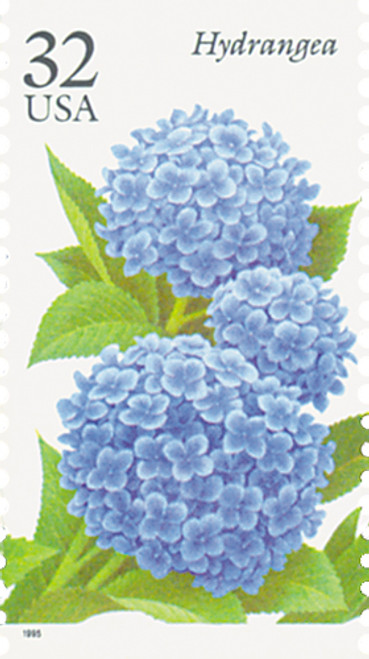
1995 32c Fall Garden Flowers: Dahlia
# 2995 - 1995 32c Fall Garden Flowers: Dahlia
$0.35 - $3.20
U.S. #2995
1995 32¢ Dahlia
Fall Garden Flowers
1995 32¢ Dahlia
Fall Garden Flowers
Issue Date: September 16, 1995
City: Encinitas, CA
Quantity: 200,000,000
Printed By: Bureau of Engraving and Printing
Printing Method: Lithographed and engraved
Perforations: 10.9 vertical
Color: Multicolored
City: Encinitas, CA
Quantity: 200,000,000
Printed By: Bureau of Engraving and Printing
Printing Method: Lithographed and engraved
Perforations: 10.9 vertical
Color: Multicolored
Dahlia
The dahlia shows how plants were dispersed worldwide during the age of exploration. Naturalist Francisco Hernandez sent some native Mexican flowers to Philip II of Spain. Captivated by the blood-red beauties, the king decreed them a Spanish possession, forbidding their removal from the royal gardens. But the living treasure could not be hoarded. Soon, dahlias appeared throughout Europe. They were named in honor of Andreas Dahl, pupil of Linneaus, originator of the scientific classification system.
Europe entered a dahlia craze. In 1838 a single plant was exchanged for a rare diamond; later, a £1,000 prize was offered for a blue dahlia. Fifty years after the dahlia’s arrival, over 2,000 hybrids had been developed from the single Mexican species. Besides adorning gardens, dahlia tubers were used for medicinal purposes. High in fructose, they helped in the treatment of diabetes, as well as kidney and liver diseases.
The dahlia (cocoxochitl) was sacred to the Aztecs. This blood-red flower symbolized the mother of their war god. Because the blooms had eight petals, human sacrifice to the god occurred every eight years. Ironically, another legend associated the cocoxochitl with Quetzalcoatl, the Aztec god of peace.
U.S. #2995
1995 32¢ Dahlia
Fall Garden Flowers
1995 32¢ Dahlia
Fall Garden Flowers
Issue Date: September 16, 1995
City: Encinitas, CA
Quantity: 200,000,000
Printed By: Bureau of Engraving and Printing
Printing Method: Lithographed and engraved
Perforations: 10.9 vertical
Color: Multicolored
City: Encinitas, CA
Quantity: 200,000,000
Printed By: Bureau of Engraving and Printing
Printing Method: Lithographed and engraved
Perforations: 10.9 vertical
Color: Multicolored
Dahlia
The dahlia shows how plants were dispersed worldwide during the age of exploration. Naturalist Francisco Hernandez sent some native Mexican flowers to Philip II of Spain. Captivated by the blood-red beauties, the king decreed them a Spanish possession, forbidding their removal from the royal gardens. But the living treasure could not be hoarded. Soon, dahlias appeared throughout Europe. They were named in honor of Andreas Dahl, pupil of Linneaus, originator of the scientific classification system.
Europe entered a dahlia craze. In 1838 a single plant was exchanged for a rare diamond; later, a £1,000 prize was offered for a blue dahlia. Fifty years after the dahlia’s arrival, over 2,000 hybrids had been developed from the single Mexican species. Besides adorning gardens, dahlia tubers were used for medicinal purposes. High in fructose, they helped in the treatment of diabetes, as well as kidney and liver diseases.
The dahlia (cocoxochitl) was sacred to the Aztecs. This blood-red flower symbolized the mother of their war god. Because the blooms had eight petals, human sacrifice to the god occurred every eight years. Ironically, another legend associated the cocoxochitl with Quetzalcoatl, the Aztec god of peace.














